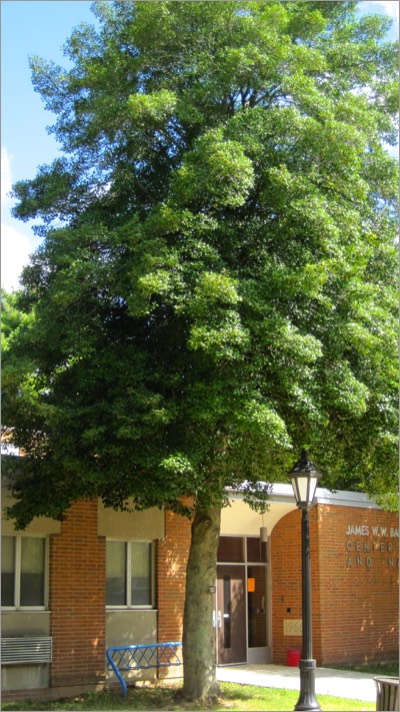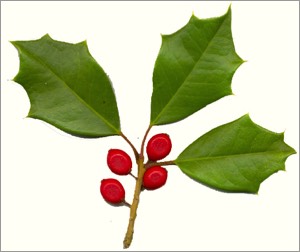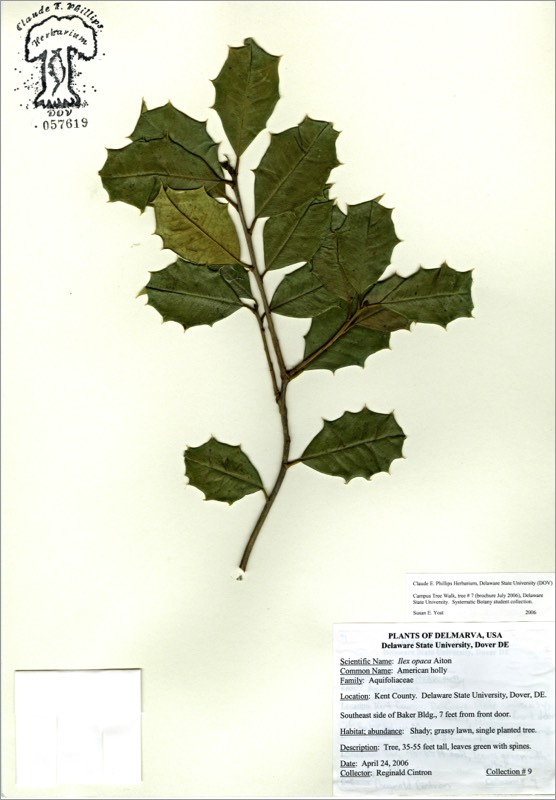Ilex opaca


Ilex opaca
AMERICAN HOLLY
Aquifoliaceae
E. North America
Locations: map coordinates E-26 (southwest corner of MLK Student Center), N 39°11'15'' W 75°32'29''; and Q-11 (next to entrance to Baker Building), N 39°11'9'' W 75°32'44''
Planting history:
E-26: planted 5/3/12, for Arbor Day, and DSU Tree Campus USA 2012 (2nd year of certification). Source: Forest View Nursery. Donated by DDA (Delaware Dept. of Agriculture).
Q-11: planting history presently unknown.
Description:
Native species, State Rank S5 (very common in Delaware)
AMERICAN HOLLY
Aquifoliaceae
E. North America
Locations: map coordinates E-26 (southwest corner of MLK Student Center), N 39°11'15'' W 75°32'29''; and Q-11 (next to entrance to Baker Building), N 39°11'9'' W 75°32'44''
Planting history:
E-26: planted 5/3/12, for Arbor Day, and DSU Tree Campus USA 2012 (2nd year of certification). Source: Forest View Nursery. Donated by DDA (Delaware Dept. of Agriculture).
Q-11: planting history presently unknown.
Description:
- small evergreen tree
- etymology: Ilex from the Latin name for holm oak/holly oak (Quercus ilex); opaca = opaque (for the dull, non-shiny, leaf surface)
- state tree of Delaware (1939); native range Massachusetts to Florida
- leaves spiny on edges
- polygamo-dioecious (separate male and female trees, with some perfect flowers); flowers small, whitish; May to June. Only female trees have berries. Important honeybee flower in Delaware
- fruit red, berry-like drupe (stone fruit); home to larvae of the holly berry midge. Considered mildly poisonous to humans, but eaten by >18 bird species (e.g. robins, cedar waxwings, mockingbirds). Formerly used medicinally for fever, colds, wounds
- wood very white, hard, smooth; used for chess pieces and looms
- shade-tolerant, understory tree grows slowly to ca 50’
- holly used as winter holiday decoration because of beautiful evergreen leaves and red berries; this tradition dates back to ancient Europe, e.g. a Germanic custom was to decorate homes with holly as refuge for woodland sprites, and Celtic Druid priests used it for warding off evil spirits (and Harry Potter’s wand was made of holly wood). Holly symbolized springtime renewal, fertility, and growth. In England, christmas trees replaced holly decorations only around 1840
- in the USA, holiday holly wreath industry started in Milton Delaware (the “holly capital of the world”), early 1900’s
- popular ornamental; with >1,000 cultivars
Native species, State Rank S5 (very common in Delaware)


There are 2 labeled American holly trees.
HIT REFRESH TO START LOCATION GRAPHIC